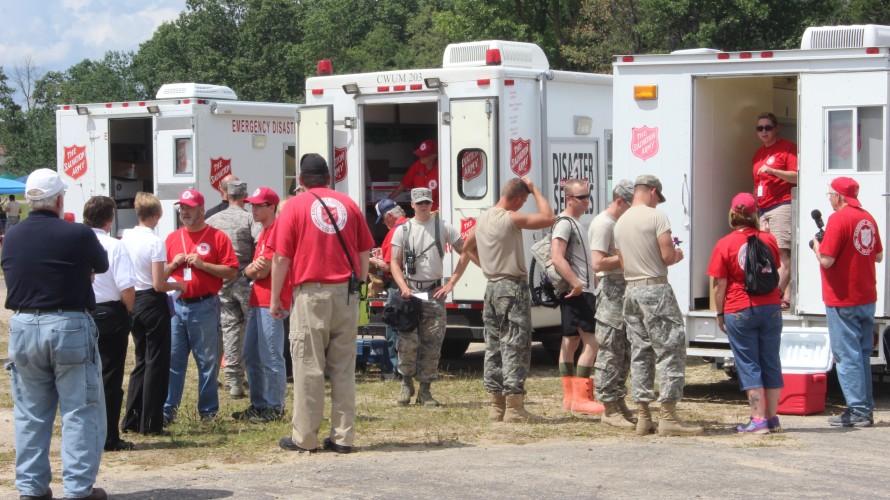The Salvation Army Participates in National Guard's PATRIOT 2015 Exercise
Krachel Greenwood | krachel_greenwood@usc.salvationarmy.org

“All in all I’d say it was a good first day, even though we had a few hiccups. That’s pretty typical during the first day of a disaster,” said Major Karen Hanton, The Salvation Army Central Territory Training Coordinator.
This week The Salvation Army is participating in the PATRIOT 2015 exercise, an annual Domestic Operations training exercise sponsored by the National Guard Bureau and accredited by the Joint National Capability Program. The training focuses on improving coordination with local, state and federal organizations. Exercise events include mass casualty, aeromedical evacuation, collapsed structures, hospital evacuation, HAZMAT along with search and rescue. Fifteen hundred Air and Army National Guard members representing 33 states have traveled to Volk Field, Wisconsin, for the training.
“The PATRIOT exercise provides a great opportunity for The Salvation Army to test our capabilities. This year we are testing real life hydration service with multiple events happening at the same time, ham radio communications and emotional and spiritual care,” said Terri Leece, The Salvation Army Wisconsin and Upper Michigan Division Disaster Services Director and Incident Commander for The Salvation Army Operation during PATRIOT Exercise 2015.
Feeding and hydrating those in need is a primary function of Salvation Army emergency disaster service teams. During this exercise crews are putting together 300 bag lunches and delivering them out in the field to National Guard members. Three mobile canteens are assisting with this function.
“The Salvation Army was exceptional. They brought the canteen in to the field hospital to provide food for those who couldn’t leave and it was much appreciated. I can quote the First Sergeant; he said, ‘Food makes people happy’,” said Kimberly Robbins, disaster and mental health volunteer for American Red Cross.
In addition to providing food and hydration during PATRIOT 2015, The Salvation Army is also testing radio communications by conducting field operations using the Salvation Army Team Emergency Radio Network, or SATERN. The SATERN amateur radio operators provide internal communication assistance to Salvation Army teams who are providing services, such as mobile feeding and emotional and spiritual care.
“In any larger disaster one of the first things to go down is telephone communications. We have all these teams spread out and without radios, there is no way to contact the crews in the field,” said Mike Levine, The Salvation Army Heartland Divisional Disaster Services Director.
“During a disaster not only are all the first responders on the phone, but family members are looking for loved ones and the phone lines just jam,” explained Leece.
“We started out by setting up the base command radio station and associated antennas. As within any disaster, problems arise. During this set up we found problems with our primary antenna system. However, knowing disasters, we always prepare by having redundancy. We put up our redundant antennas and were on the air providing field communications necessary. Once we were up and running it was a matter of adjusting the SATERN people to fit the necessary work assignments. Should situations arise later this week, what we always remember in a disaster is flexibility is the keyword. We can fix situations as we go,” said Bill Shillington, The Salvation Army Emergency Disaster Services Volunteer for Operations/Logistics and SATERN Coordinator for Central Territory.
Critical Incident and Stress Management (CISM) trained Salvation Army volunteers are providing a critical support to disaster victims and first responders by lending emotional and spiritual care.
“Our being here is by invitation because we train to CISM. We have a team of 4 participating, but the military chaplains only serve military, so the civilian population shifted to The Salvation Army. That’s kind of daunting, but also exciting,” said Major David Dalberg, The Salvation Army Metropolitan Divisional Disaster Services Director and Emotional and Spiritual Care Officer at Patriot Exercise 2015.
Through this training The Salvation Army is able to better understand the role of the National Guard and how we can help support them during a disaster. In return, the National Guard better understands the role of The Salvation Army. Together we can work to restore hope to those affected by disaster.
About The Salvation ArmyThe Salvation Army annually helps more than 30 million Americans overcome poverty, addiction, and economic hardships through a range of social services. By providing food for the hungry, emergency relief for disaster survivors, rehabilitation for those suffering from drug and alcohol abuse, and clothing and shelter for people in need, The Salvation Army is doing the most good at 7,600 centers of operation around the country. In the first-ever listing of “America’s Favorite Charities” by The Chronicle of Philanthropy, The Salvation Army ranked as the country’s largest privately funded, direct-service nonprofit. For more information, visit www.SalvationArmyUSA.org. Follow us on Twitter @SalvationArmyUS and #DoingTheMostGood.